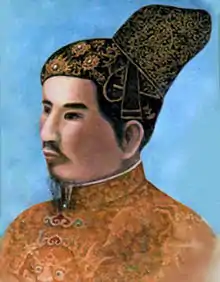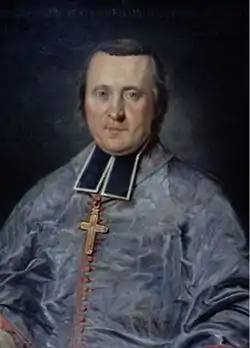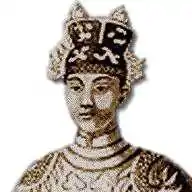Cambodian rebellion (1811–12)
The Cambodian Usurpation of 1811-1812 was when an army from Siam (Thailand) supported Ang Snguon after he overthrew his brother Ang Chan; but Vietnam sent a large army to help reinstate Ang Chan at Phnom Penh.
| Cambodian rebellion (1811–1812) | |||||||
|---|---|---|---|---|---|---|---|
| Part of Siamese–Vietnamese Wars | |||||||
| |||||||
| Belligerents | |||||||
|
|
| ||||||
| Commanders and leaders | |||||||
|
|
| ||||||
| Units involved | |||||||
|
|
| ||||||
| Strength | |||||||
| Unknown | Unknown | ||||||
| Casualties and losses | |||||||
| Unknown | Unknown | ||||||
Usurpation the Cambodian throne
Ang Chan acknowledged both Siamese and Vietnamese suzerainty over his country, Cambodia, hoping to keep the peace by paying tribute to Siam and Vietnam. Ang Snguon, Ang Chan's brother, sought Siamese aid in an attempt to usurp the throne in 1811; King Rama II of Siam sent an army, which helped to oust Ang Chan, who fled to southern Vietnam to secure aid to regain the throne. Snguon had plotted to usurp the throne (worth mentioning is that the support provided from a foreign power – Bangkok – was fairly consistent); because of a sudden military invasion, Ang Chan was compelled to leave his kingdom and to rush to reach the city of Saigon.
Seemingly perturbed, and with growing apprehension of Chan’s most friendly entente cordiale with Viet Nam and to his Emperor Gia Long,[2] the Siamese King Rama II had decided to have a more acquiescent ruler to his imposing geo-political asset; therefore, he resolved to oust Ang Chan by military pressure.
Vietnamese intervention
The next year, however, Vietnam's Emperor Gia Long sent a large Vietnamese army units which were a powerful military deterrent, whose intimidating presence in Cambodia to support Ang Chan, caused the Siamese to withdraw from the arena without sustaining major fighting on ground.
Because of the new warfare mobility – Ang Chan took Oudong supported by allied military units,[3] Viet Nam proved instrumental in reinstating the legitimate monarch over Cambodian territories and its people.
Thus, Ang Chan was enthroned again, and Gia Long became the preferential political patron and privileged relationship (i.e. authority) to Cambodia as well. It is ascertained that Cambodia, hoping to keep peaceful terms within its boundaries, had to keep an economic compromise (sending tribute) with both Siam and Vietnam.
Aftermath
The Khmer Kingdom proved weak; it alternated as a vassal to both the Siamese kings and Vietnamese emperors. Although the ascendancy gained over Cambodia was assured, there were short-lived periods of semi-independence between this protectorate and Vietnam (i.e. the military authority of Saigon).
Notes
- Footnote
- In Vietnamese record, he was called Nặc Nguyên (匿原).
- In Vietnamese record, he was called Nặc Yêm (匿俺).
- In Vietnamese record, he was called Nặc Đôn (匿𧑒).
- In Vietnamese record, he was called Nặc Chăn (匿禛).
- In Thai record, he was called Ong Ta Kun (Thai: องต๋ากุน).
- Citations
- เจ้าพระยาทิพากรวงศ์ (ขำ บุนนาค). "23. เกิดเหตุเรื่องเมืองเขมรตอน ๒". พระราชพงษาวดาร กรุงรัตนโกสินทร รัชกาลที่ ๒.
- Nguyen Anh; enthroned in the year 1802 as emperor of Vietnam.
- However, the Northern provinces were ceded to the Kingdom of Siam for compensation.
References
- A History of Cambodia By David P. Chandler
- In Search of Southeast Asia By David P. Chandler, David Joel Steinberg


